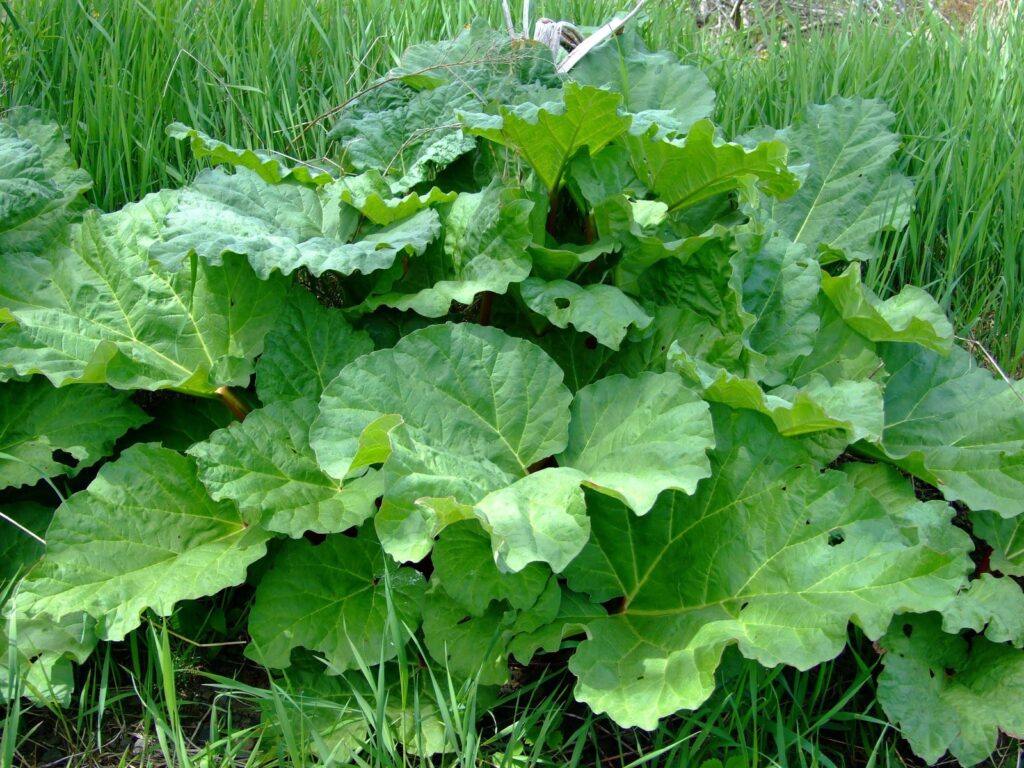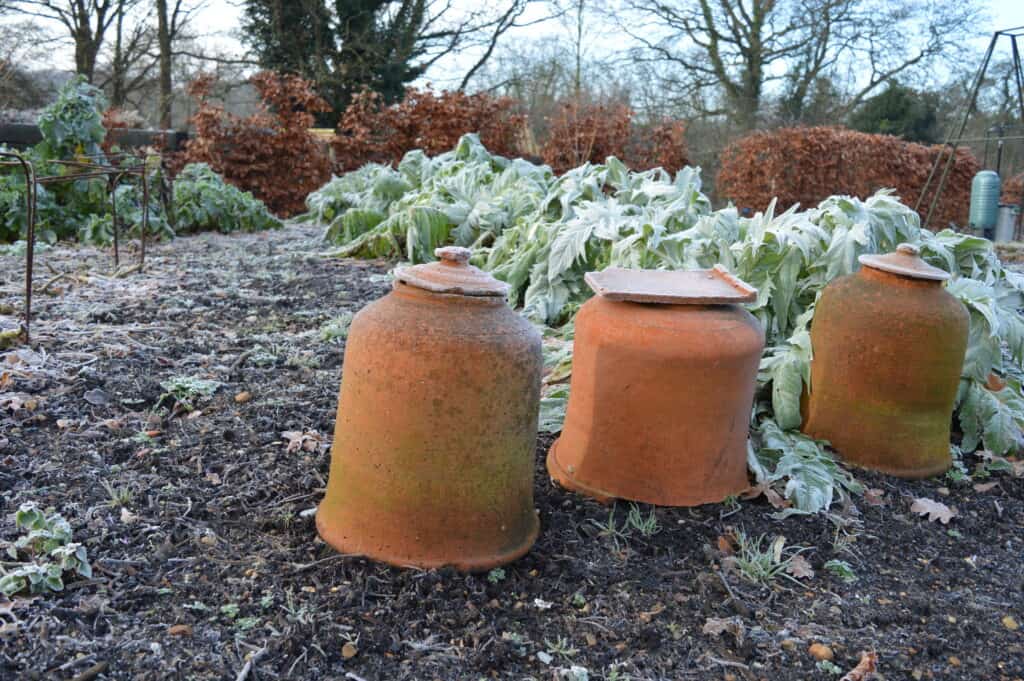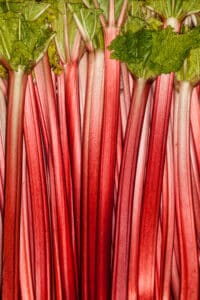Rhubarb is grown for its leaf stems (called petioles) which are thick and fleshy. The stems are colorful—cherry-red to deep red and sometimes green–and tart. They are used in jams and pies—with plenty of sugar added—and are often matched with the sweetness of strawberries.
Rhubarb is a perennial vegetable that requires a dedicated growing spot in the garden for 10 years or more. Rhubarb favors cold winters and mild summers. It may not do well where summers are hot.
Rhubarb can be grown from seeds or crowns. If rhubarb is grown from seed, the first harvest will come after 3 to 4 years. If rhubarb is grown from crowns (established roots), the first harvest will come a year after planting two-year-old crowns and two years after planting one-year-old crowns. Crowns are available in nurseries and garden centers each spring.
Rhubarb-related articles:
- Tasty Ways to Cook and Serve Rhubarb
- How to Make Rhubarb Crumble
- Rhubarb Plant Starting Tips
- How to Harvest and Store Rhubarb
- How to Plant and Grow Rhubarb

To grow rhubarb from seed, sow seeds indoors or outdoors in early spring. One year later, set plants in their permanent location.
Here is your complete guide to growing rhubarb.
Where to grow rhubarb
Grow rhubarb in deep, loose, well-drained soil rich in organic matter and compost. Choose a location that gets at least 6 hours of sun each day.
Rhubarb planting time
- Rhubarb is a hardy vegetable that prefers cool weather.
- Set rhubarb root divisions (called crowns) in garden soil 4 to 6 weeks before the average last frost date in spring or as soon as the soil can be worked.
- Crowns can also be planted in autumn.
- Rhubarb will take a year to begin harvest and four years to come to full harvest so planting time need not be exact.
- Plants can be grown from seed but will not grow true.
- Where summers are hot, stalks will grow thin and spindly; protect plants with shade cloth.
- If you grow rhubarb from seed, soak the seed in water for a half-day before sowing. Cover the seed with ½”(12 mm) of soil. Seeds will germinate in 10 days at 72°F (22°C).

Planting rhubarb
Set rhubarb crowns (roots) in the garden as early as the soil can be worked in spring. Plant one- or two-year-old crowns 1″ (2.5 cm) deep on raised mounds 6-9” (15-20cm) high and 36” (91 cm) apart. Plant the crown bud side up and firm the soil around the crown. Plant in autumn after the summer heat has broken. Plants will emerge in about 6 weeks.
- Rhubarb is a perennial plant that can live for 10 or more years. Choose a location in the garden where one or more rhubarb plants can grow for years. Each plant will require about 4 square feet; rhubarb can grow to 4 feet (1.2m) wide and tall.
- Plant rhubarb in full sun; rhubarb will grow in light shade.
- Rhubarb prefers fertile soil that is organically rich, well-worked and well-drained soil; add aged compost and aged manure or commercial organic planting mix to the soil ahead of planting.
- Where the soil is heavy clay, plant rhubarb in a raised bed.
- A soil pH of 5.0 to 6.8 is best for growing rhubarb.
- Rhubarb grows best where winter temperatures fall below 40°F (4.4°C) and summer temperatures do not exceed 75°F (24°C),
Good Products for Growing Rhubarb at Amazon:
- Garden Safe Snail and Slug Bait
- Bonide Sulfur Fungicide
- Monterey BT Caterpillar Killer
- Neem Bliss 100-% Cold Pressed Neem Oil
- Safer Brand Insect Killing Soap
- PyGanic Botanical Insecticide

Planting and spacing rhubarb
- Prepare a planting hole 18 inches (45cm) deep and 3 feet wide (.9m); add a handful of bonemeal to the planting hole and fill the hole nearly to the top with a combination of aged compost and aged manure or a commercial organic planting mix then pack the soil in. Plentiful organic matter will result in a healthy rhubarb plant.
- Set the crown or division 1 to 2 inches (2.5-5cm) deep. The growing tip should be angled toward the surface. (The rhubarb root is a rhizome or creeping rootstock; it is a sort of modified underground plant stem.)
- Set container-grown rhubarb plants even with the soil surface.
- Plant crowns or divisions 3½ to 4 feet (1.2m) apart in rows that are 4 feet (1.2m) apart.
Companion plants for rhubarb
- Grow rhubarb with other perennials such as artichokes and asparagus; set aside a dedicated growing space for perennials in your garden. Perennial vegetables can grow and produce for 10 years or more.
- You can grow cabbage family crops such as Brussels sprouts, cabbage, and kale near rhubarb, but avoid planting root crops near rhubarb.
Container growing rhubarb
- Rhubarb can be grown in a large container. Choose a container that holds at least 10 gallons of soil. Rhubarb’s large crumpled leaves make it an interesting ornamental for a patio or balcony.
- Purchase rhubarb crowns (roots) from your local garden center.
- Dig a hole and set the roots 3 to 4 inches below the soil surface.
- Stems will be ready for eating in about two years.
Watering rhubard
Rhubarb grows best in evenly moist soil. Keep the soil evenly moist throughout the growing season; do not water during the winter.
- Keep the soil moist but not wet throughout the growing; do not let the soil dry out.
- Make sure that the soil around rhubarb does not puddle in winter to avoid crown rot.
- Keep the soil moist during dry weather so that rhubarb roots do not dry out.
Feeding rhubarb
Regular applications of compost or well-rotted manure will keep plants productive.
- Fertilize rhubarb beds with aged manure in autumn and with aged compost in spring.
- Side-dress rhubarb with aged compost at midseason.

Caring for rhubarb
- Keep rhubarb beds well-weeded. Weeds will compete with rhubarb for light, water, and nutrients. Do not allow perennial weeds to grow near rhubarb, especially young plants.
- Mulch heavily around rhubarb; place a 2-inch-thick (5cm) layer of aged compost around rhubarb during the growing season; compost will help feed rhubarb.
- Mulch the planting with straw or leaf mulch during the winter to protect roots from freezing temperatures.
- Where winters are cold cover plants with 1 to 2 feet (.3-.6m) of straw to protect the crowns from freezing; remove the straw in spring when the weather warms.
- To grow rhubarb with longer, thicker leaf stalks; cover the plant with a bottomless box in early spring. The stalks will grow longer reaching for the light.
- Where winters are mild, place a sack of ice on top of the buried crown for a day or two in late winter; the plant will be tricked into thinking it has gone through a cold winter.
- Cut flowers or seed stalks as soon as they appear.
- Renew rhubarb by dividing roots when stems become crowded and thin, usually every 4 or 5 years; replant divisions in another part of the garden. (For more on how to divide rhubarb, see below.)
Rhubarb pests
- Rhubarb commonly has no serious pest problems.
- A species of weevil called rhubarb curculio can attack rhubarb. Rhubarb is a host to this pest as is dock, sunflower, and thistle. The adult sucks sap from leaves. A sign that curculio is feeding is oozing sap. Handpick and destroy these weevils.
Rhubarb diseases
- Rhubarb generally has no serious disease problems.
- Old clumps may develop crown rot if they sit in wet soil or if they are not divided every 4 to 5 years.
- Make sure the soil is compost-rich and well-drained to avoid crown rot. Add soil amendments to the planting site before planting and again in summer every year after.
- Plants with crown rot should be removed from the garden and placed in the trash.
- Ramularia leaf spot can attack rhubarb. This disease is characterized by circular, brown lesions on both the upper and lower surfaces of leaves. Spray plants with compost tea or a fungicide to control leaf spots.

Harvesting rhubarb
Let rhubarb grow for two seasons before harvesting in the third season; harvest leaf stalks for 4-5 weeks in spring; older plants can take 8 weeks of harvest. Do not eat rhubarb leaves that contain poisonous concentrations of oxalic acid. Harvest when leaf stalks are 1” (2.5 cm) or more in diameter and the stems are about 24” (60 cm) in length. Grasp each stalk near the base, pull outwards, and twist sideways; leave a few young central stalks to replenish the crowns. Rhubarb will keep in the refrigerator for 2-4 weeks; remove leaves first. Rhubarb cut and blanched will keep in the freezer for 3-4 months.
- Rhubarb harvest can begin in late spring of the second year after planting. Allow plants to establish roots the first year in the garden.
- Harvest just two or three rhubarb stems the second summer after planting.
- In the spring of the third year after planting, the full harvest of rhubarb can begin when plants are about 3 feet (.9m) in diameter and stems are thick, red, and 12 to 18 inches (30-45cm) or longer.
- Pull stalks from the crown with a sideways, twisting motion. Be careful not to damage the crown. You can also cut stalks away with a sharp knife. Always remove and discard the leaves.
- Stalks harvested in early spring will be the most flavorful; stems harvested later may be pithy.
- Harvest should last 8 to 10 weeks; stop harvesting when the only stems left are short and thin.
- Do not harvest more than one-third of a plant’s stalks in one year. Allow inner stalks to grow on for harvest next year.
- After harvest the remaining stems may die back; once they are brown and withered remove them.
- Do not eat rhubarb leaves which contain oxalic acid, a toxin.
Rhubarb kitchen sse
- Rhubarb can be stewed or baked. It can be used to make sauces, jams, and desserts such as pies, cakes, and muffins. Use rhubarb as a pie filling. Strawberry rhubarb pie is an old-fashioned favorite.
- Rhubarb can be cooked and made into compote, marmalade, or marinades. It can be incorporated into sorbets, ice cream, and punches.
Storing and preserving rhubarb
- Rhubarb stalks can be stored in the refrigerator for about one week. Crispness will diminish the longer stems are stored. (Some crispness can be restored by standing the stem in a jar of water.)
- Blanched rhubarb can be frozen for 3 to 4 months.
- Rhubarb can be canned or dried.
How to divide rhubarb
Rhubarb plants should be divided every 4 to 5 years to keep plants from crowding each other and to give them room to produce thick stalks. When stems stay thin during the growing season, it’s time to divide rhubarb. Divide plants when they are dormant either in early spring or autumn. Here’s how:
- Uproot the plant when it is dormant in early spring or in late fall.
- Cut off the top growth to expose the large crown.
- Cut away any portion of the root that is shriveled or rotten.
- Cut the crown into pieces—in half or in quarters or more; make sure there are two “eyes” or stem buds and a good portion of root in each of the pieces. Be careful not to injure stem buds during division.
- Plant pieces with two or more eyes to create new plants.

How to force rhubarb for winter harvest
Rhubarb can be forced to produce new stalks for harvest in winter. Here are two ways to force rhubarb:
- Place a large pot or box over the crown in winter. Protected from the harsh cold the plant will send up new stalks seeking sunlight. Stalks can be harvested in 6 to 8 weeks.
- Dig up a crown and expose it to the first freeze in winter. Place it in a pot or box filled with sand, and keep it moist in a place where the temperature stays cold but does not freeze. When you are ready to grow stalks for harvest, move the plant to a place where the temperature is about 60°F (15°C). Keep the plant in the dark or cover it with a 2-foot-high (61cm) box or pot to keep the light out. The plant will grow tall stalks with pale, folded leaves ready for harvest.

Rhubarb varieties to grow
Rhubarb stalks will be ready for harvest about 90 days after plants begin growing in spring. Here are popular varieties and cultivars to grow:
- ‘Chapman’s Canada Red’: heavy stalks are bright red, very sweet, and juicy.
- ‘Cherry Red’: cherry red on the outside of the stalk, greenish inside cut stalk; very tart and juicy.
- ‘Flare’: stalks are red to green, tart, and sweet in flavor.
- ‘MacDonald’s Canadian Red’: dark red stalk, the sweetest rhubarb.
- ‘Valentine’: a sweet, low acid variety that bears early.
- ‘Victoria’: classic heirloom with a tart flavor and green stalks.
About rhubarb
- Rhubarb is a hardy perennial grown for its edible stalks. The petiole or leaf stem is edible but the leaves and roots are toxic to humans and should not be eaten. Rhubarb’s large leaves have a tropical flair making rhubarb an interesting addition to the garden.
- Stalks grow up from a rhizome or underground stem called a crown.
- Botanical name: Rheum rhabarbarum
- Origin: Southern Siberia
Rhubarb articles at Harvest to Table:
How to Harvest and Store Rhubarb
Tasty Ways to Cook and Serve Rhubarb
Grow 80 vegetables and herbs: KITCHEN GARDEN GROWERS’ GUIDE
Garden Planning Books at Amazon:
- Vegetable Garden Grower’s Guide
- Tomato Grower’s Answer Book
- Vegetable Garden Almanac & Planner
- Kitchen Garden Grower’s Guide Vegetable Encyclopedia
More how to grow articles:
Learn how to plant, grow, and harvest your favorite vegetables. Click below for all you need to know.
- Artichoke
- Arugula
- Asparagus
- Beans, Snap
- Beets
- Broad Beans
- Broccoli
- Brussels Sprouts
- Cabbage
- Cantaloupe — Melons
- Cardoon
- Carrots
- Cauliflower
- Celeriac
- Celery
- Chard
- Chayote Squash
- Chickpeas
- Chicory
- Chinese Cabbage
- Collards
- Corn Salad
- Corn, Sweet
- Cresses
- Cucumbers
- Eggplant
- Endive and Escarole
- Fava Beans
- Florence Fennel
- Garbanzo Beans
- Garlic
- Horseradish
- Jerusalem Artichoke
- Kale
- Kohlrabi
- Leeks
- Lettuce
- Lima Beans
- Melons
- Mizuna
- Mustard Greens
- New Zealand Spinach
- Okra
- Onions
- Parsnips
- Peanuts
- Peas
- Peppers
- Potatoes
- Pumpkins
- Radicchio
- Radishes
- Rhubarb
- Rutabaga
- Salsify
- Shallots
- Sorrel
- Southern Peas
- Soybeans
- Spinach
- Squash, Summer
- Squash, Winter
- Sunchokes
- Sweet Potato
- Swiss Chard
- Taro
- Tomatillo
- Tomatoes
- Turnips
- Watermelon
- Zucchini















